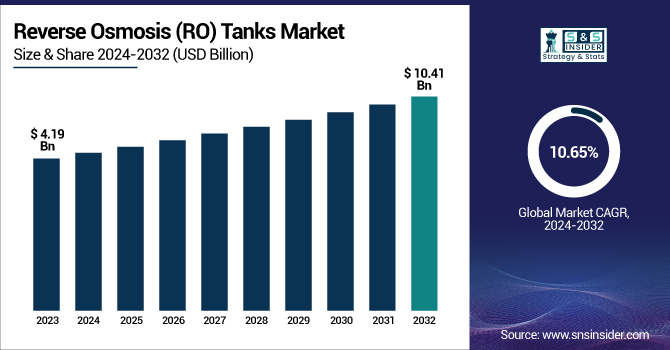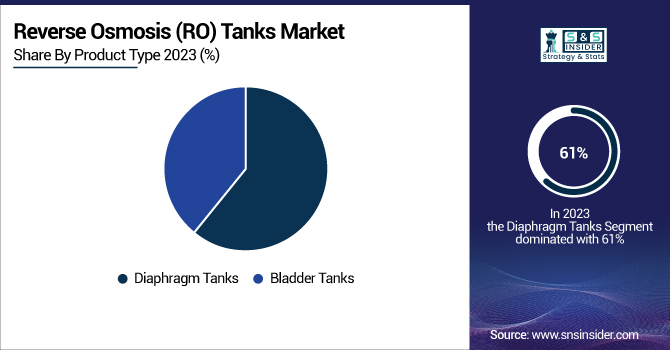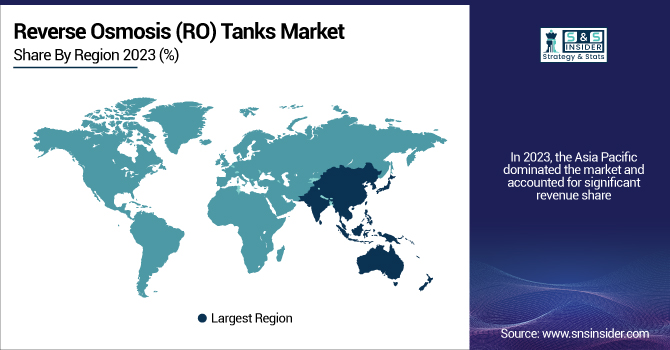Reverse Osmosis (RO) Tanks Market Report Scope & Overview:
The Reverse Osmosis (RO) Tanks Market size was valued at USD 4.19 Billion in 2023 and is expected to reach USD 10.41 Billion by 2032 with a growing CAGR of 10.65% over the forecast period 2024-2032.

To get more information on Reverse Osmosis (RO) Tanks Market - Request Free Sample Report
Modern wastewater is a significant wellspring of water contamination because of the ill-advised removal of wastewater by organizations. Many organizations are arranging wastewater without treating or overseeing it first, which is contaminating water bodies. Reverse osmosis (RO) is utilized to clean wastewater before it is delivered into a characteristic water body or permitted to stream into the channel, and in this way, it gives a green water answer to meeting et water guidelines.
RO utilizes no synthetic compounds to treat wastewater, and a RO film can be introduced in the creation line of any assembling interaction that requires clean water. High-pressure siphons powers the water through a bunch of layers post its entrance from the tank or primary feed, and these films go about as particular obstructions by catching debasements, like solids or salts. Different RO frameworks are introduced with explicit films to eliminate the expected pollution, and the water goes through RO layers as spotless water, which can be utilized for a few purposes. RO tanks are utilized often in the drug business to filter water because of their capacity of dismissing 99.9% of microbes.
Turn around assimilation is an advanced elective answer for wastewater treatment in different end-use ventures, and a state-of-the-art winding plan of RO layers can eliminate pollutants from the water feed without utilizing synthetics, gums, or particle trade beds. Expanding interest for these layers across end-use businesses and unofficial laws to check contamination and give safe drinking water are supposed to drive market income development.
Market Dynamics
Driving Factors
-
Regulations imposed by the government and rising demand for clean, treated drinking water
-
Treatment and reuse of polluted water are also highlighted in the amendment.
Restraining Factor
-
The main disadvantages are fouling and scaling.
-
The main cause of scaling in desalination plants is salt saturation on the membrane surface.
Opportunities
-
In developing countries, the need for water desalination from seas and oceans is expected to rise.
-
In emerging economies, there is a rise in demand for potable water for drinking, agriculture, and other businesses.
Challenges
-
Inland desalination facilities and RO seawater plants release thick brine into the ocean.
-
The impingement of marine animals bigger than intake screens and the entrainment of tiny organisms occur during the construction of RO seawater desalination facilities.
Impact of Covid-19
Coronavirus has built up the significance of appropriate admittance to water and sterilization. The pandemic had prompted an expansion in homegrown water interest while seeing a diminished request from organizations. In the long haul, speeding up water treatment projects, joining cutting edge computerized advances, expanding interests in emergency readiness, the versatility of staff, frameworks, and hardware in the water treatment area, and expanded political prioritization of water are supposed to support sectoral development accordingly pushing interest for treatment materials and frameworks.
Market Estimation
The report has ordered the worldwide Reverse Osmosis (RO) Tanks industry into portions including item type and application. Each section is assessed in view of the development rate and offer. In addition, the investigators have concentrated on the potential locales that might demonstrate remunerating for the Reverse Osmosis (RO) Tanks makers before very long. The provincial examination remembers solid forecasts for worth and volume, subsequently helping market players to acquire profound experiences into the general Reverse Osmosis (RO) Tanks industry.
Based on product, this report shows the creation, income, cost, the portion of the overall industry, and development pace of each kind, fundamentally split into Stomach Tanks and Bladder Tanks
Based on the end clients/applications, this report centers around the status and standpoint for significant applications/end clients, utilization (deals), piece of the pie, and development rate for every application, including Business and Private
KEY MARKET SEGMENTATION
By Product Type
-
Diaphragm Tanks
-
Bladder Tanks

By Application
-
Commercial
-
Residential
Regional Analysis:
China is the biggest exporter of apparatus including filtration of water. Different nearby and provincial producers in China are essentially drawn in with the planning and advancement of converse assimilation siphons.
The bigger presence of converse assimilation framework integrators in China has additionally led to consumable part makers. Since China is additionally one of the biggest assembling center points in East Asia, the reception of converse assimilation siphons in assembling units is supposed to increase at a pace of 7.6% over the estimated period.

Need any customization research on Reverse Osmosis (RO) Tanks Market - Enquiry Now
REGIONAL COVERAGE:
-
North America
-
USA
-
Canada
-
Mexico
-
-
Europe
-
Germany
-
UK
-
France
-
Italy
-
Spain
-
The Netherlands
-
Rest of Europe
-
-
Asia-Pacific
-
Japan
-
south Korea
-
China
-
India
-
Australia
-
Rest of Asia-Pacific
-
-
The Middle East & Africa
-
Israel
-
UAE
-
South Africa
-
Rest of Middle East & Africa
-
-
Latin America
-
Brazil
-
Argentina
-
Rest of Latin America
-
KEY PLAYERS:
The key market players are Flexcon, AMTROL, AQUASKY, 3M, Applied Membranes, Kinetico Water Systems, iSpring Water Systems, US Water Systems, FILSADAE and Other Players
| Report Attributes | Details |
|---|---|
| Market Size in 2023 | US$ 4.19 Billion |
| Market Size by 2032 | US$ 10.41 Billion |
| CAGR | CAGR 10.65% From 2024 to 2032 |
| Base Year | 2023 |
| Forecast Period | 2024-2032 |
| Historical Data | 2020-2022 |
| Report Scope & Coverage | Market Size, Segments Analysis, Competitive Landscape, Regional Analysis, DROC & SWOT Analysis, Forecast Outlook |
| Key Segments | • by Type (Diaphragm Tanks, Bladder Tanks) • by Application (Commercial, Residential) |
| Regional Analysis/Coverage | North America (USA, Canada, Mexico), Europe (Germany, UK, France, Italy, Spain, Netherlands, Rest of Europe), Asia-Pacific (Japan, South Korea, China, India, Australia, Rest of Asia-Pacific), The Middle East & Africa (Israel, UAE, South Africa, Rest of Middle East & Africa), Latin America (Brazil, Argentina, Rest of Latin America) |
| Company Profiles | Flexcon, AMTROL, AQUASKY, 3M, Applied Membranes, Kinetico Water Systems, iSpring Water Systems, US Water Systems, FILSADAE. |
| Key Drivers | •Treatment and reuse of polluted water are also highlighted in the amendment. |
| Restraints | •The main disadvantages are fouling and scaling. •The main cause of scaling in desalination plants is salt saturation on the membrane surface. |

